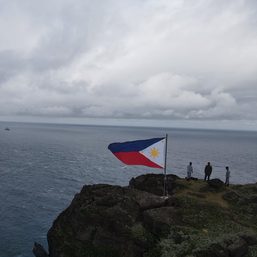SUMMARY
This is AI generated summarization, which may have errors. For context, always refer to the full article.

MANILA, Philippines – One can use many adjectives to describe Batanes: breathtaking, beautiful, stunning, and charming.

This province in the north lives up to all of the words you define it with. The rugged landscapes, verdant and rolling hills, and pristine beaches will leave you wanting more. Batanes is a place you’d want to include in your bucket list.
Get into Batanes
Philippine Airlines has direct flights from Manila and Clark to Basco, Batanes. Look out for promotions to get the lowest possible airfare for your trip.
Since Batanes is a year-round destination, the best time to visit is during the summer months from March to early May. This time provides the best weather and flight delays or cancellations are less likely to happen.
Getting around
As of writing, Batanes’ LGU only allows tour packages from Department of Tourism (DOT)-accredited operators to visit the province’s attractions. You can find a list of tour operators here.
Itinerary
The itinerary below assumes you start with one full day.

Day 1: You’ll most likely arrive in the morning. Take this time to rest and relax before going on tours around the province. Batanes is a laid-back destination, so take it slow – you’re on vacation and away from the hustle and bustle of the city. You can rent a bike to explore or simply walk around.

Day 2: On your second day on the island, go on a North Batan tour. Your most likely first stop is Tukon Church. The latter is modeled after a traditional Ivatan house with its stone façade. Another noteworthy church in your itinerary is Basco Cathedral. This place of worship is older than Tukon as it dates to the early 19th century.
The occupying Japanese built the Dipnaysupuan Japanese Tunnel during World War II. The occupiers forced the locals to dig the network of tunnels to serve as hideouts whenever battles took place. Only a few tunnels were found and opened to the public.

The Vayang Rolling Hills is a highlight of your North Batan tour. It’s a typical (but beautiful) Batanes
landscape with rolling, verdant hills as far as your eyes can see. You can take the walking paths that take
you to various viewpoints. The Basco Lighthouse sits atop Naidi Hill. You can go up to the viewing deck
for more spectacular views of Batanes.

Valugan Boulder Beach is a unique destination in the country because instead of sand, you’ll find boulders lining its beach. This distinct beachscape makes it a popular photography spot, especially during sunrise.

After your tour, head back to your accommodation to relax for the remainder of the day.
Day 3: On your third day in Batanes, you’ll be exploring South Batan. The places you’ll visit include:
Chawa View Deck
The province has plenty of beautiful landscapes; this is another one worth visiting. The jagged rock formations and the sea make for beautiful photos. The Department of Public Works and Highways (DPWH) had the view deck constructed as a rest stop for travelers traversing South to North Batan and vice versa.
San Carlos Borromeo Church
It is also known as the Mahatao Church and dates to the late 18th century.
Racuh-A-Payaman or Marlboro Country
This destination provides picturesque views of the rolling hills and the sea. There are carabaos often grazing on the hills. Take as many photos as you want during your stop.
Honesty Coffee Shop
As its name suggests, it’s a coffee shop and a store that relies on the honesty of its patrons. It has become a tourist attraction because of its noble concept.
House of Dakay

This culturally significant and historic house dates to the 1870s. It was constructed for Luisa Estrella.
Alapad Pass and Rock Formation
You’ll find a beautiful rock formation and picturesque hills when you make a quick stop here during your tour. This is the spot where you’ll find Batanes’ famous “BLOW UR HORN” sign.
Tayid Lighthouse
This non-functioning lighthouse is an attention-grabbing foreground for the surrounding verdant hills. You can take a few photos before moving on.
Diura Fishing Village
This scenic village is home to fisherfolk and boat craftsmen. There is also a stunning beachscape dotted with rock formations.
Other places in this tour circuit include: Homoron Blue Lagoon, Tuhel Spanish Bridge, Maywang A Libru
Du Batanes, Mahatao Shelter Port, and the National Museum of Batanes.
Day 4: On your fourth day, you’ll go on a tour around Sabtang to see its highlights. You’ll have to start early and catch a boat bound for the island from Ivana Port. Your tour guide will assist you during your trip.

For me, the most beautiful stop on this island is the Chamantad-Tiñan Viewpoint. The views of the jagged cliffs, beach, rock formations, and the turquoise-tinged sea are simply spectacular. I took numerous photos of the landscape.
Getting to the viewpoint is easy with walking paths and gradual descents. Like many other famous tourist destinations in the Philippines, Batanes has beautiful beaches, one of which is Morong Beach. The cream-colored coastline and the naturally formed arch make for an attention-grabbing backdrop.

Sabtang also has an old church, you’ll see the San Vicente Ferrer Church upon arrival at the port. It dates back to the late 18th century when the Dominicans had a small chapel built on its grounds.
You’ll visit the villages of Savidug and Chavayan. Here you’ll get a glimpse of the rich Ivatan culture of
Batanes. The cogon roofed stone houses you’ll find in the villages are locally called the maytuab and the
sinadumparan. After a day of exploring, you’ll head back to Batan Island.

Day 5: Eat breakfast and check out of your accommodation. You might have to leave for the airport early in the morning to catch your flight.
How much will you spend?
The most expensive expense for your trip to Batanes is the flight. A round-trip ticket costs around P10,000-P15,000 on average depending on the season per person. You can look out for promo fares to
get lower prices. A four-day and three-night tour package costs around P6,800 per person for two.
The bigger your group is the less you’ll spend. The price will also depend on the agency you book with. This covers your trip to North and South Batan and Sabtang.
The tour package also includes land and boat transfers, an accredited tour guide, lunch, and fees (registration, entrance, government, environmental, and others). Accommodation with breakfast for at least two people costs around P2,500 per night.
You can find cheaper or more upscale places to stay on the island. A budget of up to P20,000 per person for a group of two includes tours, food, and accommodation for four nights. That number doesn’t include flights and shopping. You’ll spend less or more depending on your preferred travel style. – Rappler.com
Joshua Berida is a writer that loves to travel. He blogs at www.thewanderingjuan.net.
Add a comment
How does this make you feel?









There are no comments yet. Add your comment to start the conversation.